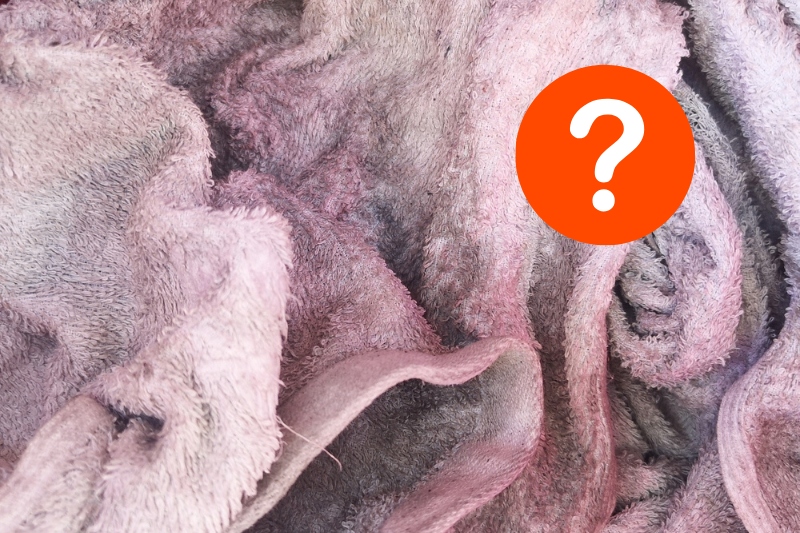There’s no denying that wrapping yourself in a large, fluffy towel after getting out of the shower is one of life’s little luxuries.
Not only do towels help dry you off, but they can also be put on display to add to the aesthetic of your bathroom.
However, it is not uncommon for pink marks to appear on your once-gorgeous towels, ruining the effect. But what causes pink stains on towels?
There are several potential causes of these unsightly stains, each of which is covered below.
We have also provided some practical stain-removal methods that will restore your towels to their pristine condition.
Why Are My Towels Turning Pink?
Many different things could be behind the pink stains on your towels. The common denominator in most cases is bleach, but some other possible culprits could also be at fault.
Each of the possibilities is detailed below:
1. Acne skin treatments
The most common cause of pink discolouration on towels is contact with acne treatments.
This includes any face wash, moisturiser, or other skin product containing benzoyl peroxide, commonly used to treat and prevent acne. Unfortunately, this ingredient is also a mild bleaching agent.
Although these low levels of bleach are not enough to harm your skin, any transfer onto the fabric of your towel will strip away some of the dye, resulting in a pink stain.
This transfer typically occurs when there are still traces of acne treatment on your hands or face when you dry them with your towel.
The active ingredient is transferred onto the material and slowly bleaches it.
2. Cleaning products
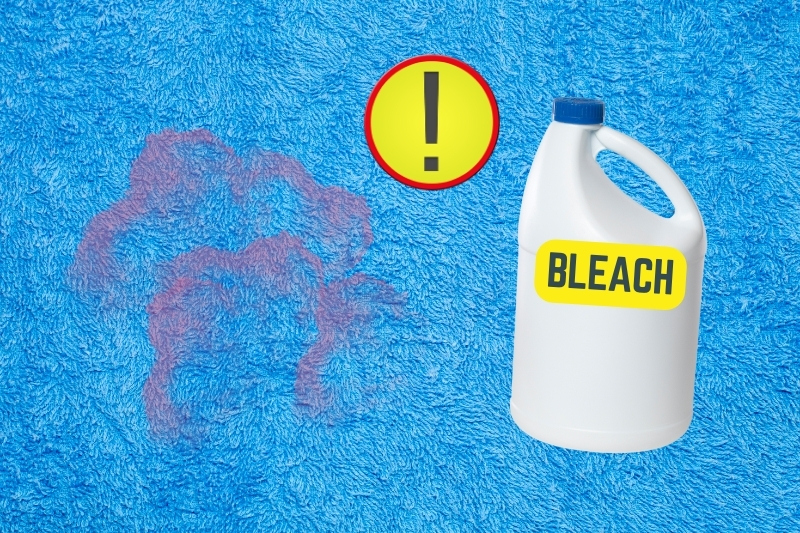
The cleaning products you use around the house commonly use harsh chemicals and bleach to remove dirt and grime.
Unfortunately, like with acne products, exposure to these cleaning solutions will strip away at the fabric dye, causing discolouration.
Although direct contact often causes these stains, it is also possible for airborne particles to absorb into your towels over time. This will eventually cause pink patches to form.
Your towels can also come into contact with these products if washed with cleaning cloths or if previous washes have left residue of cleaning products in the drum.
3. Whitening toothpaste
Whitening toothpaste is a common dental product among those that want brighter teeth. These products typically contain mild bleaching agents that remove stains from your teeth, leaving you with a pearly white smile.
Unfortunately, it is not uncommon for toothpaste to come into contact with your towel if you wipe your face after brushing your teeth.
This exposure can bleach the fabric, causing your towel to become pink as the colours are stripped from the material.
4. Pool water

If you regularly use your towel for swimming, the pink discolouration may be due to the pool water.
Chlorine bleach is used in swimming pools to ensure they are kept sanitary. To make sure the water is still safe to swim in, this bleach is kept very dilute.
This means that occasional exposure to pool water won’t have much of an effect on your towel.
However, if you regularly go swimming, repeated exposure to chlorine bleach will cause the fabric to fade and develop pink patches.
Some towels are more prone to discolouration and may develop pink stains more quickly than others.
5. Mineral deposits
If you live in a hard water area, the high quantity of minerals in your water supply can lead to the development of pink stains.
The fabric will absorb some of these minerals whenever a towel is used or washed. Unless they are regularly removed, this will eventually lead to discolouration.
These mineral deposits can also build up in your washing machine, resulting in rust. When your towels are washed, flecks of this rust can transfer to the fabric, leading to even more pink stains.
These stains can also look orange, depending on the quantity of rust and the original colour of your bathroom towels.
6. Dye transfer
Depending on the original colour of your towels, the pink discolouration could result from dye transfer. This occurs when you fail to properly separate your lights and darks before throwing them into the washing machine.
If a white towel has been washed with a red or pink item, some of the excess dye may be released during the wash cycle and leak into the fabric of the towel, leaving behind unwanted stains.
This is often the primary cause of white clothes turning pink, which can easily be avoided by sorting your laundry before washing it.
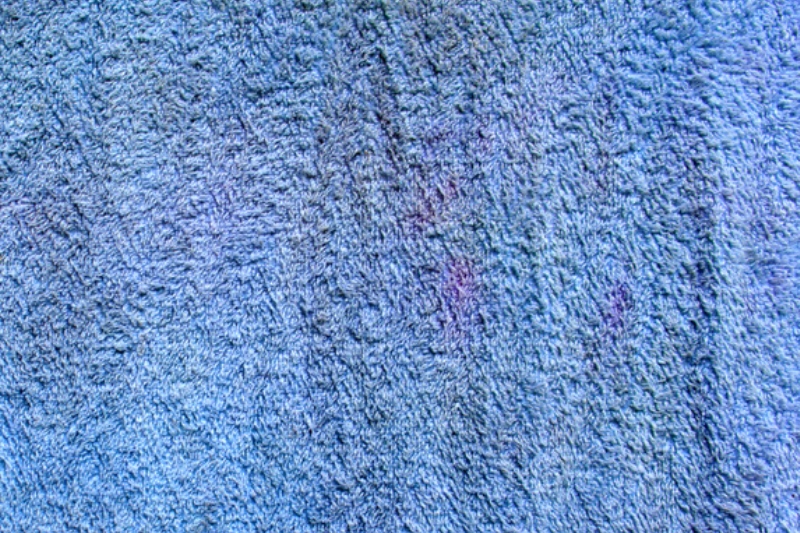
7. Pink mould
Pink mould, or Serratia marcescens, is a fungus that thrives in warm and damp environments.
This is why it is common to find pink stains in humid areas of the bathroom, such as the shower.
If your towels are not properly dried after use and are left crumpled up in a damp location, this mould can also grow on them.
This type of mould is more likely to form on your towels if they are not washed regularly. So, in general, it is best to switch out your towel every week and ensure it is always left to air dry after use.
How Do You Get Pink Stains Out of Towels?
Having unsightly pink stains appear on your towels can be very frustrating. Fortunately, there are ways to fix this issue without replacing all your towels.
The most effective way to do this depends on the cause of discolouration. Once you’ve identified the root of the problem, you can choose the best method from the list below.
Removing bleach stains
If the pink stains have been caused by exposure to a bleaching agent, you will need to restore the original colour of the towel to the affected area.
This can be done in several ways depending on the towel and the size of the stain:
1. Rubbing alcohol
Rubbing alcohol is a solvent that will break down dye when it comes into contact with the fabric. If you only have small pink stains, you can use this to your advantage by loosening the excess dye in the towel and moving it over the discoloured area.
To do this, lightly rub at the area around the stain until the dye comes loose, then dab the excess over the pink section of fabric until the original colour has been restored.
Towels typically don’t have much excess dye, so it’s not the best stain removal method. Nevertheless, it will help cover up small patches of discolouration.
2. Fabric dye and markers
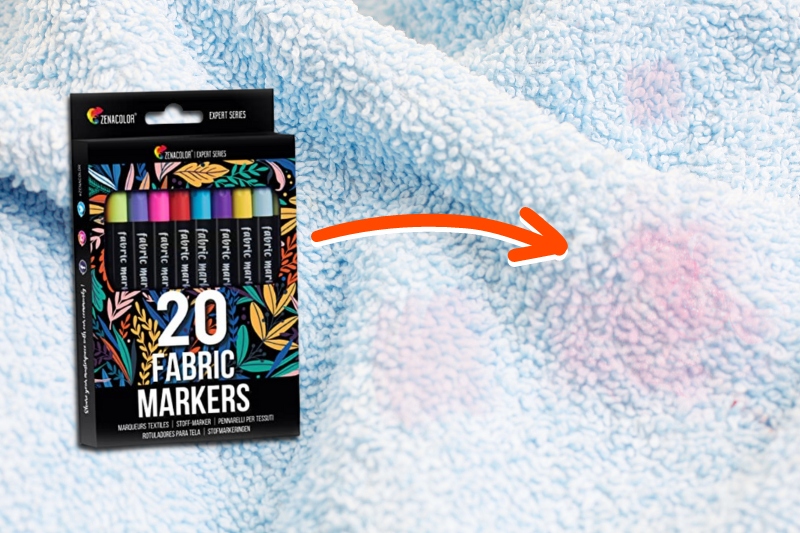
The best option for restoring large patches of discolouration caused by bleaching is to use fabric dye.
The end result may look a bit uneven if the colour match is not perfect, but it will still help cover up the pink stains and make them less visible.
For the best results, you should always dye your towel according to the instructions packaging.
For more minor stains, you can also purchase fabric markers like these fabric pens from Zenacolor that match the original colour of your towel. Use the marker to colour in the stained area and then wash it according to the label instructions.
3. Diluted bleach
If none of the above methods are for you, your last option is to use a diluted bleach solution to even out the colour of your towel.
Please note that this will not restore the original colour to the towel, but it will make the rest of the fabric match the pink patches more closely so that they are not noticeable.
To do this, dilute your bleach according to the label instructions and fully submerge your towel in the solution.
Let it soak for the recommended time before thoroughly rinsing the fabric in cold water and washing it as usual. Make sure to wear gloves when working with bleach to avoid skin irritation.
Removing mineral deposits & rust
Pink staining due to mineral deposits or rust can be fixed using water and white vinegar.
To make the solution, dilute 240 ml of vinegar into 4 litres of water and soak your towel for roughly 30 minutes. You can then thoroughly rinse the fabric and wash it as usual.
Correcting dye transfer
The most effective way of restoring white towels after they have been discoloured by dye transfer is to bleach them.
Make sure to wear protective gloves, and then prepare a solution of 60ml of bleach and 4.5 litres of water. Submerge your towel in the solution for 5 minutes and then rinse thoroughly to remove the bleach.
If needed, repeat the treatment until the pink has completely disappeared. Once you’re satisfied, wash your towel and leave it to dry.
Removing pink mould
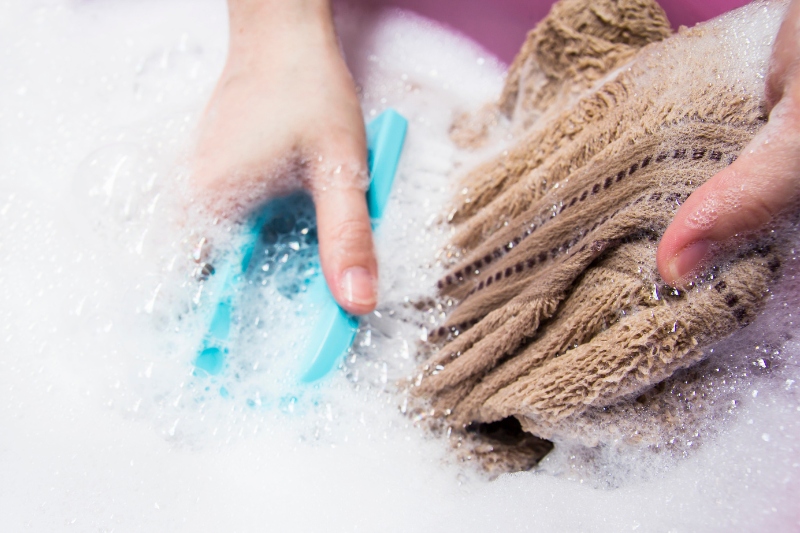
If the discolouration on your towels is due to pink mould, the best solution is to thoroughly wash them.
To ensure all of the mould is removed, use a good quality detergent and the highest temperature setting recommended on the towel’s care label.
We advise washing the affected towels separately from the rest of your laundry to avoid cross-contamination.
After washing your towels, hang them to dry in a well-ventilated area. If any staining remains, you can use a mild bleach solution to eliminate them, but check the care label first to ensure the towels are bleach-safe.

Hannah has a passion for cleaning. She worked her way around Australia by cleaning hostels in exchange for free accommodation and used her cleaning skills to bag a job as a chalet host for a luxury ski company in France.
